
Few groups have ever captured the love of the industrial cognoscenti as Haujobb have. Renowned for making “thinking person’s industrial”, Daniel Myer and Dejan Samardzic (and for their first two LPs Björn Junemann) have carved out a nigh-unassailable position as innovators and challengers to genre standards. Tempting as it is to fail to distinguish between Haujobb’s catalog and the broader work of the incredibly prolific Myer, there’s clearly some unreproducible chemistry between Myer and Samardzic which is responsible for Haujobb’s legacy. In anticipation of their forthcoming LP New World March, their first in eight years, we’ll be discussing each of their six full-lengths to date.
A brief preemptive disclaimer: we here at ID:UD fucking love Haujobb. Any criticisms of any of the records below should be taken in the context of our understandings and appreciations of their body of work as a whole. In other words, we’d likely take any of the tracks or albums we critique herein over 99% of the material floating about in the genres Haujobb touch upon in a heartbeat. It takes a certain kind of nerd to examine the shortcomings of the things you love. We are those nerds.

Homes & Gardens
Bruce: Haujobb’s debut is something of a messy affair, an everything-and-the-kitchen-sink attempt to build atmospheres of all kinds around arpeggios (often straight out of Bites, but who’s counting). This is a far cry from the stunning displays of pure craft alongside experimentation the Haujobb brand would come to be known for, but there’s no question that it’s a fun listen, warts and all. Myer opts for muddled, growling vocals rather than the calculating, detached croon he’d adopt on later records, and while it’s not the best approach for him, it occasionally works, as on the classic new-world-order/panopticon paranoia cut, “Eye Over You”. It’s a damn shame more bands don’t take their debut as an opportunity to field test sounds half as much as Haujobb did.
Alex: Homes & Gardens is significantly more “industrial” than any of the work that would follow. Listening to a track like “Maternal Instinct” now is an odd experience, whereas the production and sample work that define Haujobb is present in full measures, it’s still in service of a different kind of sound. Which is not to say that Homes & Gardens is bad by any stretch of the imagination, it still sounds pretty great some 18 years later. It just often feels like the group were applying an already rapidly forming aesthetic of lush and orchestrated sounds to a song-writing template they would move beyond in short order. “Yearning” to me has always specifically sounded like an attempt at a Front Line Assembly song, one that has what Haujobb would become poking in from around the edges.
It’s also worth noting that the dearly departed Pendragon Records put out Homes & Gardens in North America as their first release. The label would go on to be the home of bands like Gridlock, Imperative Reaction and Velvet Acid Christ, issuing some of the best Industrial releases of the 90s, and remain a mark of quality for those in the know. Pour one out.
NB: Homes & Gardens was recently reissued and remastered with some bonus material by Dependent/Artoffact. Buy it here.
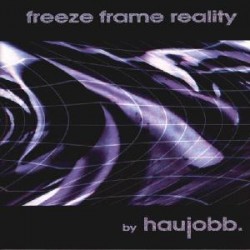
Freeze Frame Reality
Alex: This is where Haujobb becomes Haujobb. Although the songs aren’t separated from the ones on Homes & Gardens by some enormous chasm, they’re just put together in a way that feels very much like Haujobb to me. To whit, instead of leads and basslines being pushed way out in the mix, songs like “Dream State” and the stunning “Nezzwerk” feature elements that sneak into the mix as if emerging from a fog, coalescing in clever and unusual ways.
That said, the use of guitar on this album has never worked for me. It always sounds like a distraction, an unnecessary addition to a landscape that actually detracts from many of the subtler and more delicate elements that surround it. Thankfully it’s not present on every track and many of the songs that are saddled with it like “World Window” get the remix treatment omitting it they deserve later.
Bruce: I’ll come clean(er) and say that this is the weak spot in Haujobb’s catalog for me. Rather than expanding on the experimental aspects of Homes & Gardens, it feels as though one of the modes from that record was simply chosen as a template for pretty much the entirety of their sophomore release. While this does make FFR a cohesive listen, it doesn’t necessarily make it a rewarding one. There’s also a muddiness to the mix which I don’t feel serves their material well (although that could just stem from the fact that I’ve long been in awe of the depth and clarity of their later production). I really prefer the subsequent Frames – The Remix Album to this LP which it took as its starting point.
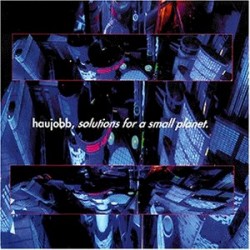
Solutions For A Small Planet
Bruce: …And here we go. The point at which not only Haujobb boldly leap into the uncharted interzones between industrial, electro, IDM, drum n’ bass and ambient, but the point at which an entire genre is forced to sit back and take stock of itself. If you had even the slightest interest in pushing the limits of electro-industrial in ways beyond “louder/faster”, Solutions was a game changer.
Alex: Solutions is born perfect, a precise and focused blend of EBM, sophisticated techno and masterful studio technique. I got chills the first time I heard it: “Anti/Matter”‘s loping break and swirling lead building to the string sounds on the bridge, the quixotic but genius inclusion of saxophone on “The Cage Complex”, the bubbling and constantly evolving “Net Culture”…it was unlike any music I had heard in or out of the genre at that point in my life, probably because nothing like it truly existed yet. With the benefit of a few more years of study I can see the throughlines from groups like Uwe Schmidt’s Lassigue Bendthaus, but no one had managed a feat like Solutions, an intense and concentrated record of “thinking person’s EBM”.
Bruce: Solutions marks a thematic shift for Haujobb. Rather than gleefully celebrating the chaotic freedom early net culture seemed to promise or resorting to paranoid manifestos (both endemic to early cyberpunk and much electro-industrial), Haujobb approach technology and its impact on culture in a far more thoughtful and reflective way. More “New Rose Hotel” than Neuromancer, if you catch my drift.
Alex: This is also where Daniel Myer’s voice comes into its own. Up ’til Solutions, it was largely relegated to afterthought status, a means of delivering lyrics, but not an instrument in its own right. The rich baritone we know now comes out in full force here, emotive and completing. It’s a distinctly human element that serves to throw Haujobb’s more “cold” elements in sharp relief, the context that allows much of their music to transcend the inherently antiseptic nature of this style of electronic music.
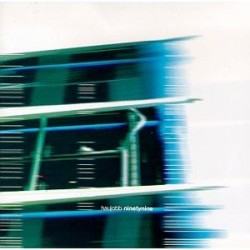
ninetynine
Alex: I’ve always vaguely suspected that ninetynine started life as one of Myer’s other, more IDM oriented projects. I recall at the time that the band had put out promo material touting an album to be called “Cut Copy Cycle”, whether the album we eventually received some time after it’s initially promised delivery date was a rejig or a complete overhaul has never been clear. I also recall that ninetynine was pretty divisive amongst fans at the time, some feeling that the duo had gone too far in direction of lush, sophisticated IDM with touches of drum n bass and trip hop, while others praised it for eschewing genre conventions and leaving the dancefloor behind almost entirely. Both sides have a good point, this doesn’t really feel like any Haujobb album before or since, it’s starkly minimal and entirely unagressive nature suggesting an eventually unrealized new direction for the duo. I’ll happily go to bat for it as an example of a band I like expanding into new territories, songs like “Less” and “Overflow” (both of which feature Vanessa Brigs on vocals) are ludicrously lavish and well worth paying attention to.
Bruce: Regardless of its origins, there’s no denying that ninetynine is the odd one out in the Haujobb catalog. While interstitial remix comp Matrix hinted that there was a desire to explore space and texture rather than beats within the Haujobb camp, the pure, calming waves of ninetynine went far beyond that record and remain the most minimal tracks to which Myer has ever lent his hand. (I think. I mean, I own about thirty of the dude’s releases but even I can’t say for certain that one of the Dots+Dashes or S’Apex 12″s doesn’t have a pure drone track on it.)
When I initially reviewed this album nearly ten years back, I lamented that “as thoroughly developed and enjoyable as it is, ninetynine is a testament to the barriers that exist between the increasingly stratified genres of electronic music…Haujobb’s experimentation was met with accusations of selling out and going soft. The only problem with that accusation is that there wasn’t anyone to sell out to. In a just world, records like ninetynine would be picked up and celebrated by aficionados of chill and ambient, but it looks as though many of those people are as unwilling to listen to an ambient record put out by an industrial band as industrial fans.” While a tad clumsy, I’ll more or less stand by that sentiment. Myer’s effortless leapfrogging across electronic genres deserves recognition and acclaim from well beyond the boundaries (as hazy as they might be) of Our Thing.
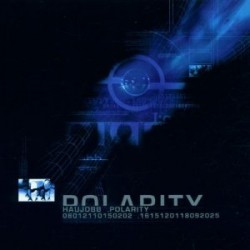
Polarity
Bruce: While there’s no question that Solutions is Haujobb’s breakthrough album, Polarity remains my favourite. I could attempt a critically objective defense of this position, that it takes the template of Solutions and slows the beats down enough to bring the texture and polish of the tracks to the forefront, that the influence of the likes of Radiohead and Unkle is apparent in the new sense of dynamism which infuses this record, but at the end of the day, I just love this record with every fiber of my being. At a time when I was beginning to grow aware and wary of the thousands of cliched tricks and presets in the electro-industrial handbook, Polarity was a bracing splash of cold water, opening up my ears to sounds I’d never heard and instantly becoming the soundtrack to innumerable late night bus rides and study sessions.
Polarity remains one of the most evocative electronic albums I’ve ever heard. The high-futurism of Solutions is abstracted to Ballardian extremes: I see impenetrable, unpopulated cities of black glass and blue light self-replicating in snowy wastelands. Abandoned gunships frozen over and beginning to crack. Revenge visited via nanites. Architecture as social criticism. Shit, I haven’t the faintest fucking clue what this stuff means, it’s just where Polarity takes me even today, ten years after its release.
By the way, if, like me, your copy of Polarity featured a disruptive second of silence mid-beat on “Demon”, and you wondered if this was an intentional interjection, a brilliant bit of structural self-critique, a Cage-like space for disruption and reflection amidst the album’s most anthemic yet dissociative track…um, nope. Apparently it’s just a pressing error. (ETA: Actually a DAT error which went uncorrected and was then butchered in a reissue – check the comments below for the real scoop!)
Alex: I’ve never really known where to stand on Polarity as a full LP. It has some excellent songs (“Boom Operator” and “Subsonic” are personal favorites) and it has all the hallmarks that make Haujobb great, the impeccable production, the subtly effected textures and so on. But it just never hung together that well for me. Maybe it’s the fact that there are only nine “proper” songs on it, the rest of the running time made up by interstitial bits of sound collage, which are lovely and neat in equal measures, but are just little sketches and aren’t terribly substantial. Although I remember playing it out a lot, this is the album from their discography that I probably touch on least. There’s nothing bad about it, it’s just that aside from the aforementioned tracks it’s never struck me as hard as the rest of their work.
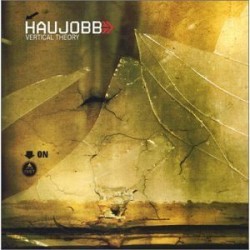
Vertical Theory
Alex: Vertical Theory is really strong album, and probably their second best objectively speaking (Solutions being the generally agreed upon high watermark). The first three songs especially “Renegades of Noize”, “S.adow”, and “The Noise Institute” are incredibly put together, products of meticulous sound manipulation and careful programming, music that blooms as you listen to it, revealing heretofore unsuspected depth. I generally recommend this as a starting point for the band because I think it rewards the casual listener a lot, grabbing the ear in ingenious ways, even if you aren’t specifically trying to pick details out as you go along. I also feel like the version of “Penetration” (released as a single the previous year) is a pretty amazingly succinct summation of the band. Had they never put another record, this would have the ideal moment to end on.
Bruce: While indisputably an archetypal Haujobb record following in the tradition of Solutions and Polarity, the interim release of the booming, churning, and legitimately epic Penetration single in retrospect looks to be a bit of a fake-out prior to this, the last Haujobb LP prior to their lengthy hiatus. While offering a museum of immaculately sculpted sounds, too often those sounds sit in antiseptic isolation from one another. That’d be all well and good if Vertical Theory had the ambient ambitions of ninetynine, but that’s not the case here. Take “The Noise Institute” for example. A rubbery single synth note hits again and again and again, with some minimal drums and vocals hanging on for its duration. While that note sounds really, really, really cool (and shifts in pitch a couple of times), it isn’t enough to get the track off the ground by itself. There are a couple of exceptions to this: “Concrete” holds everything together really well, and while a little trancey for my tastes, “A Terrifying Truth” has a nice propulsive sense.
As a disclaimer, I should say that I’m probably carrying a lot of baggage when it comes to Vertical Theory, coming as it does on the heels of my beloved Polarity and Penetration. Upon its release I had very particular expectations of what a Haujobb record “should” sound like (much like the rec.music.industrial dude Alex pointed to), and may be deaf to its motions to minimal techno, micro house and the like.
Everything Else (Singles, EPs, Remix Albums)
Alex: Haujobb have always dealt in a lot of material external to their central albums, and to their credit it usually feels pretty complimentary when taken in the context of their oeuvre. As noted previously Frames – The Remix Album is practically an essential purchase for the discerning fan, collecting as it does a variety of mixes that add some depth and frame of reference for the early albums. I’m myself incredibly fond of the Cleaned Visions single, an incredible display of what the ‘Jobb can do with some orchestral samples, and which bears not a single resemblance to the similarly titled track from Solutions. Speaking of which, the Matrix remix album contains a whole CD of samples, essentially the DNA that makes up Solutions For a Small Planet and that made appearances on records by such notables as Beefcake for years afterwards. And for my money possibly the best thing to come out of ninetynine (appearing on its remix companion record) is the Red Sparrow remix of Overflow, a perennial favorite for late night bus rides and walks under halogen streetlights.
Bruce: As mentioned above, Penetration is an excellent secondary entry in the Haujobb catalog, with a good range of mixes (I’ll take the “Floormix” and Forma Tadre’s interpretation) and a pretty nice instrumental. Vertical Mixes fleshes out the spacious feel of its origin material, with Glis delivering a tasty dancefloor take on “Slide” and our boy Yann from Iszoloscope applying his trademark maelstrom of cacophony to a killer mix of “The Noise Institute”. The brand-new Dead Market EP offers a glimpse into what New World March might have to offer: a taught, propulsive, and characteristically brilliant cut. We can’t wait to hear what’s next.


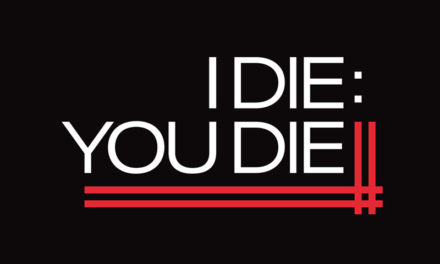


Great coverage of one of the few bands in the scene that still has staying power for me.
And just so’s you know, I fucking love ninetynine. That was my White Rock-Vancouver bus ride music for the longest time.
Thank you so much guys. You put a lot of effort into this;)
Oh, and on Demons on Polarity it was actually a dropout on the
DAT Cassette. We were never told, that its there and for the
repressing they just decided, to remove half of the verse with
the error in it. Bastards;)
Glad you enjoyed it, Daniel, and thanks for the extra info about “Demon”!
Can’t wait to hear the new album.
Wow, a big thank you from me, too! This was like time travelling! Btw, take a look at the spelling of my name;)
Argh, sorry Dejan! Will correct it forthwith. Very excited about the new album!
Ooops, sorry about that! Glad it prompted some trips down memory lane.
+1 “Overflow”